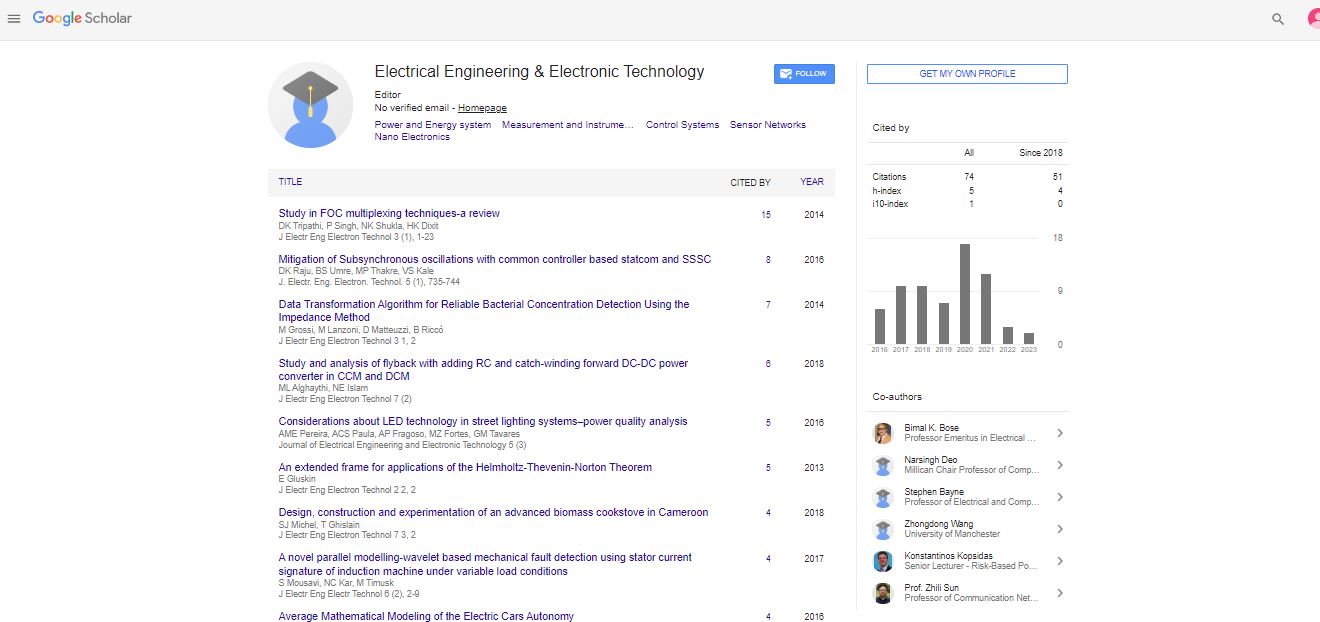Fabrication of liquid molds using drop-on-demand printing technology for bio-PDMS mirofluidic devices
Lijun Yang, Baochun Lu, Li Zhu and Xiaoyang Zhu
Nanjing University of Science and Technology, China
: J Electr Eng Electron Technol
Abstract
I n the last few decades, biological microfluidic chips have been attracting considerable interests in the area of biosensors and bioelectronics due to the characteristics of less consumption of samples, less analysis time and portability. Recently, there have been many studies on biosensors and bioelectronics using biological mircofluidic chips. However, PDMS is often the preferred material for the prototyping of microfluidic devices as it is easily to be bonded, transparent, durable, nonfluorescent, biocompatible and nontoxic. To date, there have been many methods developed to fabricate bio-PDMS mirofluidic chips such as soft-lithography, screen-printing, liquid molding and wax printing. However, most of these methods require numerous complex steps, making the fabrication expensive and not easy. The fabrication of molds is the key step of bioPDMS microfluidic chips preparation. In this paper, a new drop-on-demand printing method based on the digitallization of microfluidic technology was described to fabricate liquid molds which were used in Bio-PDMS microfluidic devices. In the drop-on-demand printing system, a glass micro-nozzle filled with glycerin solution is fixed with the PZT actuator through a connecting device. The glass micro-nozzles used in this paper were fabricated in four steps. The liquids in the micro-nozzles were jetted on the glass substrate which was hydrophilic treated by TiO2 NPs solution by the pulse inertia force supplied by a PZT actuator. The diameter of the liquid droplets is controlled by the inner diameter of glass micro-nozzles, the driving frequency and voltage of the digitalization of microfluidic system. The liquid lines can be formed on the hydrophilic glass substrate by changing the overlap of the liquid droplets using a computer-controlled motorized X-Y worktable. When the substrate is hydrophobic or less hydrophilic, the neighboring droplets were difficult to connect with each other. When the overlap is 60%, line bulges would be produced. When the overlap of the substrate is 30%, the liquid lines seemed to be well formed on a hydrophilic substrate. The fabrication process of the bio-PDMS microfluidic device was shown. Firstly, the glass substrate was cleaned and hydrophilic treated with TiO2NPs solution, then the 50% glycerin solution was printed on the substrate to form liquid molds. Afterward, the PDMS liquid was poured on the liquid molds and been put in a driving oven for 12 hours at 60°C. The PDMS concave mold was peeled off from the substrate and drilled after being cured. At last, the PDMS device was bonded with another PDMS by pressing and maintaining at 75°C for half an hour. Three dimensional surface profile of a PDMS micro-channel replicated form a liquid mold was shown. The width and the height of the channel were about 100 μm and 8 μm. The surface roughness of the micro-channel was about 179 nm. Result showed that based on the digitallization of microfluidic technology, the glycerin liquid could be jetted steadily on the glass substrate, and the diameter of the liquid droplets was controlled by the system parameters. With the overlap of 30% on the hydrophilic substrate, the liquid line seemed to be well formed. After that, the PDMS concave mold for Bio-PDMS device was well fabricated. The liquid molds printing system is simple structured, the glass micro-nozzles are easily fabricated and low cost. This method suggests a novel path which is easy, inexpensive and portable in the area of biological microfluidic devices fabrication.
 Spanish
Spanish  Chinese
Chinese  Russian
Russian  German
German  French
French  Japanese
Japanese  Portuguese
Portuguese  Hindi
Hindi 
